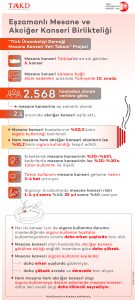As a result of the analysis, which is a first in the world in terms of the size of the data and based on the data obtained from the “Turkish Urooncology Association’s Bladder Cancer Database” project, updated by the Turkish Urooncology Association with the unconditional support of AstraZeneca Turkey, the effect of tobacco use on the co-occurrence of bladder and lung cancers development unclosed in the light of stunning data.
Cigarette consumption is a common problem in Turkey as well as all over the world, and the relationship between this consumption and lung cancer is often emphasized in public information studies. This is because lung cancer is the most common cancer. However, there are many other cancers and diseases associated with cigarette consumption, the most notable of which is the urinary bladder or the bladder cancer. Bladder cancer is quite common in our society, and according to current data, it is the 6th most common cancer in our country and the 10th among cancer-related deaths.1
 Although the relationship between these two common cancers, which occur due to cigarette consumption, is known, there has not been a study in our country in which these two cancers were evaluated together. A study was carried out using the data in the Bladder Tumor Database, which was created, with the unconditional support of AstraZeneca Turkey, within the body of the Turkish Urooncology Association and developed with the contribution of the leading centers of urological cancers in our country. In this study, the relationship between smoking and the development of bladder cancer in Turkey, the characteristics of bladder cancer in smokers in the diagnosis and treatment processes, and perhaps most importantly, its relationship with the development of lung cancer were examined on a scientific basis. This study is also the first to evaluate the association between smoking and bladder and lung cancer in the light of our country’s data. The Turkish Urooncology Association and the Turkish Society of Lung Cancer came together for this study, which was carried out with data obtained from 2,568 patients. The results of the study were shared with the public at the press conference held with the unconditional support of AstraZeneca Turkey as part of the 31 May World No Tobacco Day. The results of this comprehensive study were as follows:
Although the relationship between these two common cancers, which occur due to cigarette consumption, is known, there has not been a study in our country in which these two cancers were evaluated together. A study was carried out using the data in the Bladder Tumor Database, which was created, with the unconditional support of AstraZeneca Turkey, within the body of the Turkish Urooncology Association and developed with the contribution of the leading centers of urological cancers in our country. In this study, the relationship between smoking and the development of bladder cancer in Turkey, the characteristics of bladder cancer in smokers in the diagnosis and treatment processes, and perhaps most importantly, its relationship with the development of lung cancer were examined on a scientific basis. This study is also the first to evaluate the association between smoking and bladder and lung cancer in the light of our country’s data. The Turkish Urooncology Association and the Turkish Society of Lung Cancer came together for this study, which was carried out with data obtained from 2,568 patients. The results of the study were shared with the public at the press conference held with the unconditional support of AstraZeneca Turkey as part of the 31 May World No Tobacco Day. The results of this comprehensive study were as follows:
The effect of tobacco use on the co-occurrence of bladder and lung cancers
In line with the outputs obtained from the Bladder Cancer Database, the effect of tobacco use on the co-occurrence development of bladder and lung cancers was determined. In the study, the information of 2,568 patients registered in the Turkish Urooncology Association Bladder Cancer Database was evaluated. 2.1% of bladder cancer patients were also simultaneously accompanied by lung cancer, 9.9% of them by chronic obstructive pulmonary disease (COPD), and 0.5% by lung cancer and COPD. 50.3% of bladder cancer patients and 81.2% of both bladder and lung cancers patients were smoking. Both types of cancer were diagnosed at an earlier age in smokers than in non-smokers. The incidence of lung cancer in patients with bladder cancer is higher than in healthy people. The risk of developing lung cancer increases even more in those who have bladder cancer and smoke. It was observed that lung cancer developed after an average of 3.7 years in patients with bladder cancer, and bladder cancer developed after an average of 4.2 years in patients with lung cancer. In addition, quitting smoking before does not reduce the risk of developing both bladder and lung cancers. Bladder cancer is observed at an earlier age in smokers, and smokers are diagnosed at a higher stage and grade. Patients who smoke are more likely to go to surgery for bladder cancer, which requires the removal of their bladder completely, and the risk of developing complications after the surgery increases in these patients. Again, the risk of recurrence of the disease, the risk of progression of the disease, the risk of spreading the disease to other organs and the risk of death are higher for these patients. Bladder cancer is more advanced and more fatal in those who continue to smoke and have both bladder and lung cancers.
“Turkey ranks 9th in the world in the incidence of lung cancer”
Board Chairman of Turkish Society of Lung Cancer Prof. Dr. Atila Akkoclu said that 20 million people smoke in Turkey in 2021, the highest rate is in the 35 – 44 age group, and the smoking rate in men is 53% and in women is 24%2. Akkoclu shared the following information about lung cancer: “Lung cancer cases in Turkey are seen at a rate of 74.8 per 100K in men and 10 per 100K in women. Lung cancer ranks first in men and fourth in women in the frequency of newly diagnosed cancer within a year. The average age of lung cancer, which is seen in approximately 41,000 new patients every year, is 60. 90% of the patients are smoking, and 90% of the smokers are men. Unfortunately, 70% of the patients go to the doctor in the advanced stage. However, according to the data of the World Health Organization (WHO), more than 2 million people (11.6% of all cancers) are diagnosed with lung cancer as of 2018. Lung cancer ranks first among cancer-related deaths in the frequency of deaths, with 22% in men, and second in women after breast cancer with 13.8%. While Turkey ranks ninth in the world with 36.9 per 100K incidence of lung cancer, it ranks third in the world after Hungary and Serbia with 74.8 per 100K for men.1 Lung cancer can’t wait. For this reason, it is of great importance for smokers to pay more attention to this disease and to have the necessary medical examinations done on time.”
“Tobacco use increases the risk of developing bladder cancer 3-4 times”
Stating that tobacco use is the most important risk factor for bladder cancer and increases the risk of developing bladder cancer 3-4 times3, Turkish Urooncology Association Chairman of the Board Prof. Dr. Guven Aslan said, “This risk is directly related to the duration of tobacco use and the number of cigarettes smoked per day. It was also seen that the risk of developing bladder cancer is higher in both current smokers and former smokers compared to those who have never smoked.” Aslan adds: “50% – 65% of newly diagnosed bladder cancer cases in men and 20% – 30% in women are related to tobacco use. Bladder cancer-related deaths are second only to lung cancer in smoking-related cancer deaths. Those who start smoking at an earlier age have a higher risk of death from bladder cancer. The fact that bladder cancer patients are diagnosed at an older age suggests that there is a 30-year delay between starting smoking and being diagnosed with bladder cancer. However, a sudden decrease in the risk of bladder cancer is observed in those who quit smoking. This decrease is 40% after 1 to 4 years of quitting smoking, and 60% after 25 years. 3 Since tobacco smoke contains cancer-causing substances such as beta-naphthylamine and aromatic hydrocarbons, these particles cause inflammation in the bladder and other parts of the body and stimulate cancer development by making mutations in cancer-causing and tumor-suppressing genes in DNA. Therefore, encouraging people to quit smoking will reduce the incidence of bladder cancer in men and women. Low-tar cigarette smoking also does not protect against bladder cancer. The same effect applies to electronic cigarettes. It has been observed that there is an increase in cancer-causing substances in the urine of people who use electronic cigarettes.”
References:
1 – Ferlay J, Ervik M, Lam F, Colombet M, Mery L, Piñeros M, Znaor A, Soerjomataram I, Bray F (2020). Global Cancer Observatory: Cancer Today. Lyon, France: International Agency for Research on Cancer. Available from: https://gco.iarc.fr/today, erişim tarihi [26 Mayıs 2022]
2 – https://www.tuseb.gov.tr/tuhke/uploads/genel/files/dunya_tutunsuz_gunu.pdf
3 – Freedman ND, JAMA. 2011 Aug 17; 306(7): 737–745.



